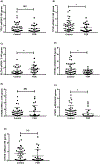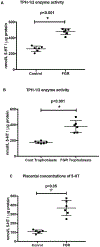Disrupted placental serotonin synthetic pathway and increased placental serotonin: Potential implications in the pathogenesis of human fetal growth restriction
- PMID: 31176514
- PMCID: PMC6724713
- DOI: 10.1016/j.placenta.2019.05.012
Disrupted placental serotonin synthetic pathway and increased placental serotonin: Potential implications in the pathogenesis of human fetal growth restriction
Abstract
Objectives: Placental insufficiency contributes to altered maternal-fetal amino acid transfer, and thereby to poor fetal growth. An important placental function is the uptake of tryptophan and its metabolism to serotonin (5-HT) and kynurenine metabolites, which are essential for fetal development. We hypothesised that placental 5-HT content will be increased in pregnancies affected with fetal growth restriction (FGR).
Methods: The components of the 5-HT synthetic pathway were determined in chorionic villus samples (CVS) from small-for gestation (SGA) and matched control collected at 10-12 weeks of human pregnancy; and in placentae from third trimester FGR and gestation-matched control pregnancies using the Fluidigm Biomarker array for mRNA expression, the activity of the enzyme TPH and 5-HT concentrations using an ELISA.
Results: Gene expression for the rate limiting enzymes, TPH1 and TPH2; 5-HT transporter, SLC6A4; and 5-HT receptors HTR5A, HTR5B, HTR1D and HTR1E were detected in all CVS and third trimester placentae. No significant difference in mRNA was observed in SGA compared with control. Although there was no significant change in TPH1 mRNA, the mRNA of TPH2 and SLC6A4 was significantly decreased in FGR placentae (p < 0.05), while 5-HT receptor mRNA was significantly increased in FGR compared with control (p < 0.01). Placental TPH enzyme activity was significantly increased with a concomitant increase in the total placental 5-HT concentrations in FGR compared with control.
Conclusion: This study reports differential expression and activity of the key components of the 5-HT synthetic pathway associated with the pathogenesis of FGR. Further studies are required to elucidate the functional consequences of increased placental 5-HT in FGR pregnancies.
Copyright © 2019 Elsevier Ltd. All rights reserved.
Figures





References
-
- Clausson B, Cnattingius S, Axelsson O, Outcomes of post-term births: the role of fetal growth restriction and malformations, Obstet. Gynecol 94 (5) (1999) 758–762. - PubMed
-
- Nardozza LMM, et al., Fetal Growth Restriction: Current Knowledge, Archives of Gynecology and Obstetrics, 2017, pp. 1–17. - PubMed
-
- Frøen JF, et al., Restricted fetal growth in sudden intrauterine unexplained death, Acta Obstet. Gynecol. Scand 83 (9) (2004) 801–807. - PubMed
-
- Figueras F, Gratacós E, Update on the diagnosis and classification of fetal growth restriction and proposal of a stage-based management protocol, Fetal Diagn. Ther 36 (2) (2014) 86–98. - PubMed
Publication types
MeSH terms
Substances
Grants and funding
LinkOut - more resources
Full Text Sources
Miscellaneous

